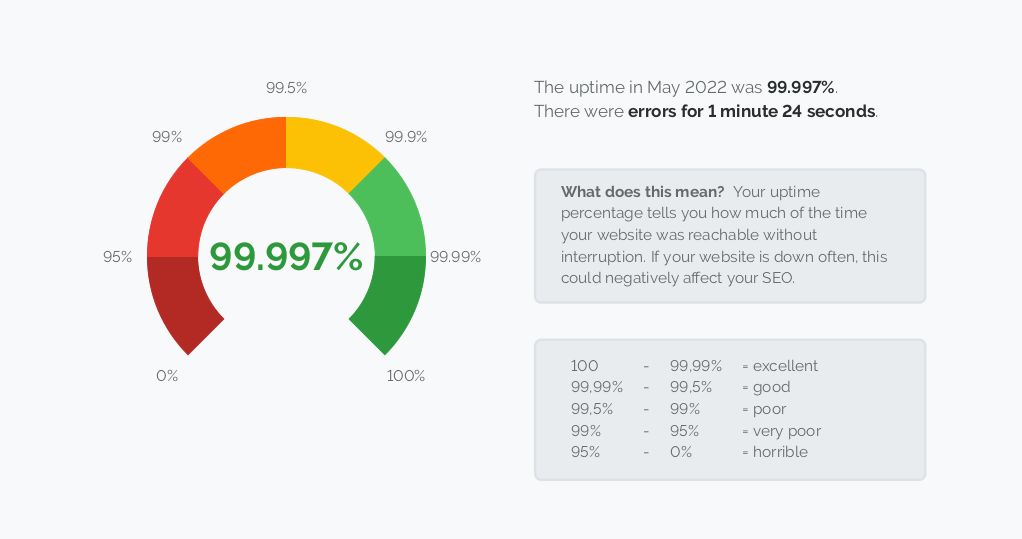What is downtime?
When referring to websites, downtime means that your website cannot be visited because it is unavailable. Downtime can be planned, for example, during maintenance (which we will discuss at the end of this article), but usually, downtime is unexpected. Possible causes are a power outage, a human error, network issues, a cyber-attack or too much traffic flowing towards one server.
Should I care about the downtime of my website?
A website with inconsistent performance is like having a bad sales manager on the road. Sales fall through at the last minute, and clients are left hanging because they are not getting the information they need. Not to mention the damage it does to your reputation when people complain on social media that your services are down.
What is the financial cost of downtime?
According to a 2014 paper by technological research firm Gartner, the average cost of downtime for a company is 5,600 dollars per minute and 140,000 dollars per incident. A more recent Uptime Institute’s 2022 Outage Analysis Report states that 60% of failures result in at least 100,000 dollars in total losses, which is a 39% increase compared to 2019.
But what about me?
How much does downtime cost you? That depends on how much your company relies on your website and how often it is down. And in the current digital age, there is no such thing as an unimportant website. Let’s find out how you can get the exact number instead of an industry average.
How do I calculate the cost of downtime for my company?
Atlassian recommends multiplying your minutes of downtime by the cost per minute. But for that, you first need to know that your website has been down. We will explain how to find that out in the following paragraphs. For a more detailed estimate, use the downtime cost calculator Belgian hosting company Combell has created. The tool uses seven parameters which help you accurately calculate the cost of downtime. These parameters are:
- The duration of the downtime
- The loss of income
- The loss of productivity
- The cost of repair
- The lost sales opportunities
- Clients that you have lost
- Compensations you have to pay.
You can find the cost of downtime calculator here. The website is in Dutch, so you might need an on-page translator.
Why “My website is never down” is a lie
Most people think their website performs well simply because they never receive complaints about it. You don’t know how your website performs because nobody will tell you when it’s in trouble. Even powerhouses like Facebook, Instagram, and Google suffer outages from time to time.
What is an acceptable downtime percentage?
No website is up 100% of the time, but you should aim for a monthly uptime percentage of 99.95%. It comes down to about 3.5 of downtime per month. Fun fact: insiders often refer to the number of nines when talking about uptime. Five nines (99.999%) is the holy grail, four nines (99.99%) equate to almost 52 minutes of downtime per year, and three nines (99.9%) mean 8.77 hours of annual downtime. So make sure to check what your hosting company is promising you!
Where can I find the uptime percentage of my website?
That’s the tricky part: nobody will give you this information. The only way to get your uptime percentage is to monitor your website and log when it is down. That is why we created a tool that does it for you: Semonto. We believe that every website owner has the right to know how well their website performs. Our objective results reveal if you are getting the hosting services you need. If your uptime is terrible, it’s time to find a better hosting company.

What about planned downtime?
It’s best to avoid downtime at all times, even during maintenance. If you are performing maintenance on your website, causing some services to be offline, make sure to do it overnight when the effect is limited. Send a communication to your users so that they are aware. Use status pages to keep people in the loop. Also, make sure to use the correct HTTP status code (HTTP 503) so that SEO web crawlers know that this interruption is planned and that they should return later.
Know your website’s downtime with Semonto
Semonto is a website monitoring tool that alerts you when your website is down. This way, you can fix the problem or warn the person in charge of your website so that they can resolve the issue. (Not sure who manages your hosting? We wrote an article about that.) On top of that, Semonto keeps track of your monthly uptime percentage. You can consult it in your dashboard at all times or export a PDF report. Besides your uptime, Semonto also checks your website for broken links, security issues and more. Want to try it? Sign up for a free trial, and let us know your thoughts!








